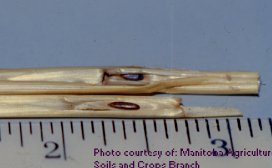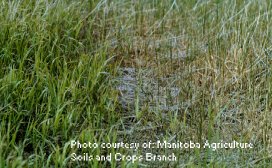Hessian Fly


Substantial yield reductions in grain and forage occur when these crops are heavily infested with this pest. Toxins released during feeding interfere with normal wheat growth.
Host Crops
Wheat (spring and winter) is the preferred host of the Hessian fly. Barley, oats, triticale and rye are generally considered resistant. Wild grasses (ex, quackgrass, western wheatgrass, rye grasses) are also hosts.
Biology
There appears to be a spring and a fall generation. For winter wheat, the fly invades fields in September and establishes the fall generation. A second generation occurs the next spring. The insect survives the summer as a 4th- instar larva in the "flaxseed" stage in infested wheat stubble. This shiny-brown, seed-like puparium can be found at the base of old plant crowns. It also may occur in straw, near the nodes, behind the leaf sheaths.
Rain will trigger fly emergence in early September. Farmers who plant winter wheat early will have young wheat in the seedling stage when the flies emerge. The potential for infestation and damage to sensitive, young plants is high.
Young wheat plants or tillers are preferred for egg laying. Typically, the eggs are laid in rows, looking like a string of "hot dogs", when viewed with a magnifier.
The reddish, 1st-instar larvae move from the empty egg shells and crawl downward, gradually reaching the base of the leaf. Here, between the leaf and tiller, the young larva begins to feed, with its head in a downward position.
A single larva, feeding for just 3 days, is capable of stunting a young wheat plant or tiller. The larvae feed for about 2-3 weeks. They then form the puparium that resembles a "flaxseed". The non-feeding 4th-instar larva overwinters within this structure.
Some mortality occurs each winter, depending on many factors, including temperature, moisture and natural enemies. In the spring, development resumes and the larva transforms into a pupa, still inside the puparium. The spring emergence of adult flies follows within a few days. The adult life is short, lasting an average of only 2-3 days.
| May | June | July | August | September |
| Larvae pupate, flies emerge and begin laying eggs | Egg laying, hatching, larval feeding in spring wheat | "Flaxseed" stage in stubble | "Flaxseed" stage in stubble | Flies emerge, lay eggs, larvae feed in winter wheat |
Scouting Techniques
Winter wheat plants infested in the fall can easily be recognized by their darker than normal colouration and leaves with unusually broad blades. Young plants or tillers infested in the fall often die during the winter. Plants attacked in the spring have shortened and weakened stems that may eventually break, causing plants to lodge near harvest.
Scouting provides information useful in planning next year's crop rotations. Wheat can be checked just after emergence. Hessian fly is easiest to detect in the "flaxseed" stage. Look for areas of poor stand and stunted plants in the field.
Collect about 50 stems from throughout the field, avoiding field edges. Examine the base of these plants by pulling back the sheaths of several leaves and looking for the dark-brown, flaxseed-like puparia.
Economic Thresholds
When a field becomes infested, control measures will not work. Control is based entirely on prevention.
Control Tips
The use of resistant varieties alone or in combination with delayed planting dates and destruction of volunteer wheat has greatly reduced risks associated with this pest.
Flies emerging in late-summer or early-fall will lay eggs on any available host plant, including volunteer wheat. If this wheat is destroyed, the earliest emerging flies have fewer egg laying sites. By harvesting wheat early and discing under or burning stubble, much of the population can be eliminated. Discing the stubble under completely is more effective than burning.
Because the Hessian fly is a weak flier, rotation of crops over a wide area can help to reduce infestations. Never plant wheat in the same field 2 years in a row, especially if no-tillage practices have been followed.
Because the fly lives for only a short time in the fall, delayed planting of wheat can help eliminate the overlap between the presence of flies and newly emerged winter wheat. Winter wheat planted in August will most likely be susceptible to attack. Winter wheat planted in September will likely be fly-free.

